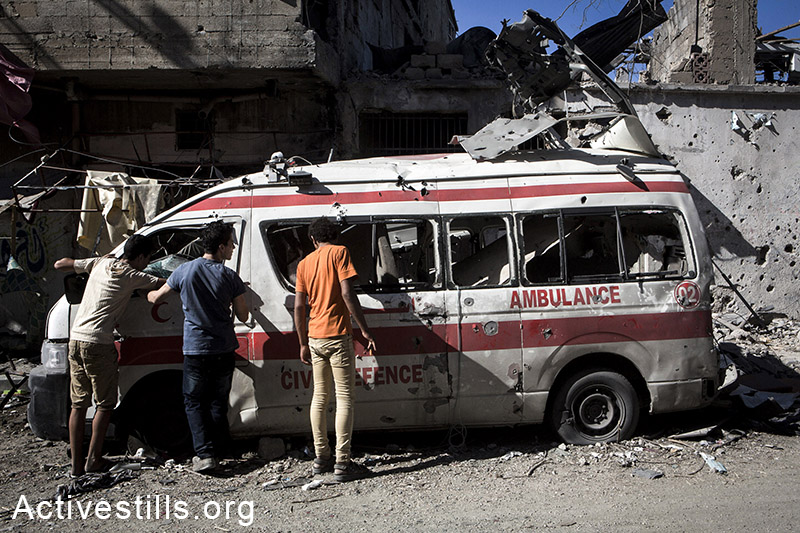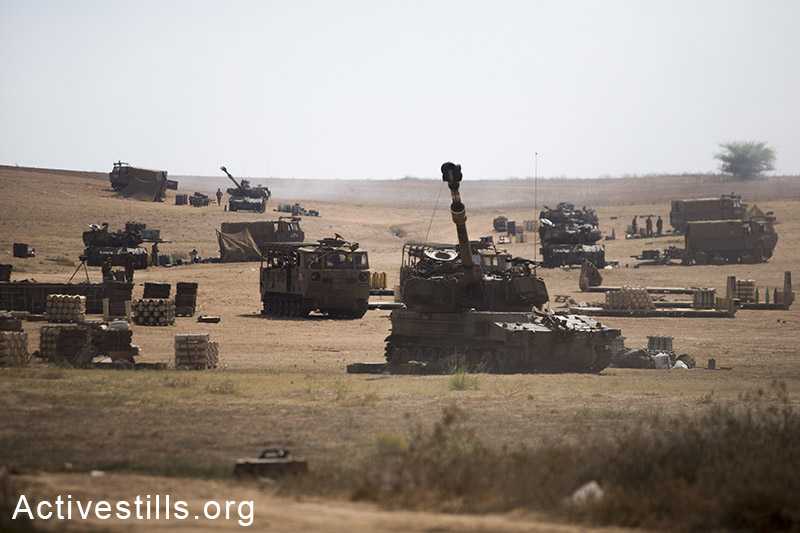Israel’s ‘no-go zone’ – created by scorched-earth shelling that has leveled entire neighborhoods – has shrunk Gaza nearly by half.
A colleague in Gaza City’s Tal el Hawa neighborhood reported before dawn this morning that Israeli tank shells were falling all around the apartment building where he and his wife were hunkered in a hallway, contemplating where they could flee come sunrise. Between them and the Mediterranean sea to their west are fewer kilometers than those separating them from Shejaeiya to the east, where days earlier, Israeli tanks had reduced entire neighborhoods to rubble.
“They’re doing to us like they did to Shejaeiya,” my colleague said. Although the sun has barely risen in Gaza and the damage not yet fully surveyed, by all accounts, last night’s bombardment was the fiercest yet in central Gaza—and this time it came from tanks, too.

I strain to grasp the tactic. Hadn’t Benjamin Netanyahu, just hours earlier, forecast further violence by vowing to destroy Hamas tunnels? Never mind that the tunnels had only recently figured into his rationale for what Germany’s largest-circulation daily, Sueddeutsche Seitung, called the “Gaza-krieg.” If “destroying tunnels” was Netanyahu’s casus belli, what on earth were Israeli tanks doing so close to Gaza City, in the heart of the Strip?
And are the tanks there to stay?
As Israel stepped up its shelling of northern and eastern Gaza earlier on Monday, the first day of the Muslim feast marking the end of Ramadan, Netanyahu’s military endgame began to look a lot like what Palestinians feared most – a return to the status quo. Only this time, with the shelling reaching central Gaza, the picture looks far more bleak.
A map published Thursday by the UN Office for the Coordination of Humanitarian Affairs paints the picture, offering a striking visual of what may be Gaza’s new de facto “border.” The map shows an Israeli-imposed “no-go zone” extending three kilometers into the Strip from its northern to southern tips—an area representing 44 percent of Gaza’s total land mass and within which, presumably, Israeli tanks unleashed hell upon Gaza City last night.
If past is precedent, that expanded area will be a virtual shooting gallery for Israeli soldiers long after the present military maneuvers end, and only Palestinians willing to risk life and limb will dare enter. Just ask residents of the eastern and northern Gaza districts abutting Israel. Long before their homes were devastated by shelling, they understood just how lethal their enforced penury was. In the so-called “buffer zone,” which officially extended only 300 meters into Gaza, human rights organizations had documented Israeli snipers firing at Palestinian civilians up to 1.5 kilometers from the border with Israel.

With Israeli troops now enforcing their “no-go” policy in an area twice as deep, Palestinian civilians beyond that zone face a similar and persistent threat, as evidenced last night. In fact, as the OCHA map shows, Palestinians living in the northern three-quarters of Gaza may all be within shooting distance of Israeli snipers. That is certainly the case in Gaza City, where thousands of displaced Palestinian families have sought shelter. UN spokesperson Chris Gunness said yesterday that more than 170,000 Palestinians—or nearly 10 percent of Gaza’s population—were seeking shelter at facilities run by the UN Relief and Works Agency.
Making matters worse, the Israeli military later in the day issued fresh evacuation orders to residents of northern Gaza, raising fears that attacks there would escalate to levels that saw entire neighborhoods leveled in Beit Hanoun and Shejaeiya. And even as more people fled toward Gaza’s center, the military dropped a new flyer on Gaza City, listing names of alleged Hamas members killed by airstrikes and asking, tauntingly, “In your opinion, whose name will be written in the coming publication?” (Palestinian journalist Lara Aburamadan displayed the flyer on Twitter).
Click here for +972′s full coverage of the war in Gaza
The threat came as news broke of yet another attack on a medical facility—this time also in the heart of Gaza City. As NBC’s Ayman Mohyeldin reported, the attack struck an outpatient clinic of Gaza’s main hospital, Al Shifa, at around the same time that 10 people, including children playing outside, were killed by an Israeli airstrike on the Shati refugee camp.
The attacks show no sign of abating. Within hours of the Shati attack, Netanyahu called for Hamas to be demilitarized and said that Israel would continue targeting tunnels along its border with Gaza. But with that “border” now nearly halving Gaza’s territory and hundreds of thousands of Palestinians forced to cram into central Gaza areas still under bombardment, Netanyahu is clearly targeting far more than tunnels. In fact, his actions are drawing Israel ever farther from a compromise, and it’s hard to imagine Hamas acceding to a ceasefire under these conditions.
Indeed, the group has vowed to continue fighting until Israeli troops leave Gaza and displaced residents return home. That, too, seems like a distant prospect: Even if a ceasefire deal allowed displaced Palestinians to return to northern Gaza, it’s unlikely they would be able to stay there unless the ongoing Israeli embargo is lifted—a key Hamas demand—and they are allowed to rebuild.
All of which brings us back to a lesson John Kerry has already learned: Palestinians in Gaza are fed up with the status quo, and at this point—after bearing the blows of three full-scale Israeli assaults in five years—they have little left to fear. This much is for certain: if the bombing ends tomorrow but the so-called buffer zone remains, Gaza’s resistance will continue. The only question is whether the world will pay attention when today’s massacres become tomorrow’s one-off murders again. If it doesn’t, we can be sure that the massacres will return again soon.
In the meantime, the killing continues.
Related:
Why did Israel reject Kerry’s ceasefire proposal?
Five Israeli soldiers killed in Gaza; Palestinian death toll hits 1,088
Protective Edge: The disengagement undone


